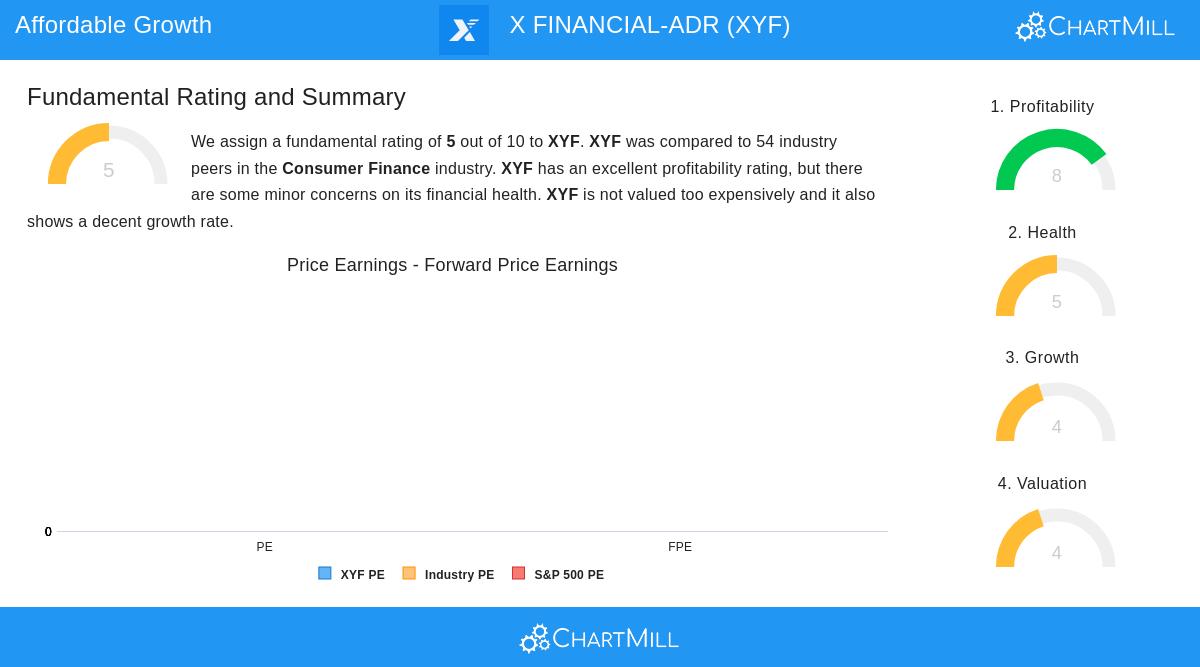X FINANCIAL-ADR (NYSE:XYF): A Peter Lynch-Style GARP Investment
By Mill Chart
Last update: Sep 2, 2025
In long-term investing, few strategies have shown as much practical success as the approach promoted by Peter Lynch. His methodology, detailed in One Up on Wall Street, highlights finding companies with lasting growth, fair valuations, and good financial health, a philosophy often called Growth at a Reasonable Price, or GARP. Instead of following speculative trends or trying to time the market, Lynch supported a disciplined, fundamental-based process that concentrates on businesses an investor can comprehend and keep for long periods. This structure has been used to search for possible opportunities, and one name that recently appeared is X Financial-ADR (NYSE:XYF).

X Financial works as an online personal finance company located in Shenzhen, China, offering technology-based personal finance services including the Xiaoying Card Loan and Xiaoying Preferred Loan, plus a wealth management platform. The company’s WinSAFE risk control system improves its capacity to evaluate borrower risk, placing it in the increasing fintech sector. When measured against Lynch’s standards, XYF seems to match well with the main ideas of his strategy.
Sustainable Growth and Valuation A main idea of Lynch’s approach is earnings growth that is strong yet lasting, usually between 15% and 30% each year over a five-year span. XYF’s EPS has increased at an average rate of 16.75% over the last five years, putting it solidly within this goal range. This shows a company growing at a steady speed, lowering the chance of overheating or sudden declines. Supporting this growth is a very appealing valuation, shown by a PEG ratio of only 0.18, much lower than Lynch’s favored limit of 1. The PEG ratio, which modifies the P/E ratio for growth, suggests the stock could be priced low compared to its earnings growth possibility, a main part of Lynch’s strategy for finding good deals in growing companies.
Financial Health and Profitability Lynch gave great importance to good balance sheets and high profitability, which help a company survive economic changes and put money back into growth. XYF displays a debt-to-equity ratio of 0.34, much lower than the strategy’s highest limit of 0.6 and even Lynch’s stricter preference for ratios below 0.25. This careful borrowing lowers money risk and shows a dependence on equity instead of debt funding. Also, the company’s current ratio of 1.50 is above the minimum need of 1, showing enough short-term cash availability. For profitability, XYF’s return on equity (ROE) is 21.99%, exceeding the 15% standard and highlighting effective use of shareholder money.
Fundamental Overview A wider review of XYF’s basics supports its status as a well-placed company. It gets a profitability grade that is high in its industry, with good margins and returns on invested money. Financial health is acceptable, though there are small items to watch, like the Altman-Z score. Valuation measures indicate the stock is low-priced both compared to industry rivals and the wider market, while growth has been steady in the past, even without future estimates. For a complete analysis, readers can see the full fundamental report here.
Contextual and Strategic Considerations While the number-based filters match closely with Lynch’s screen, investors should also think about non-number aspects he stressed, like business simplicity and insider belief. As a fintech company, XYF works in a sector that might face regulatory shifts and competitive forces, needing more careful research into its business model and market conditions. Also, the absence of future growth estimates means investors must depend more on past patterns and management statements when judging lasting power.
For those wanting to look into other companies that fit this strategy, more screening results can be found using the Peter Lynch Strategy stock screener.
Disclaimer: This article is for informational purposes only and does not constitute investment advice. Investors should conduct their own research and consult with a financial advisor before making any investment decisions.
7.12
+0.21 (+3.04%)
Find more stocks in the Stock Screener
XYF Latest News and Analysis



